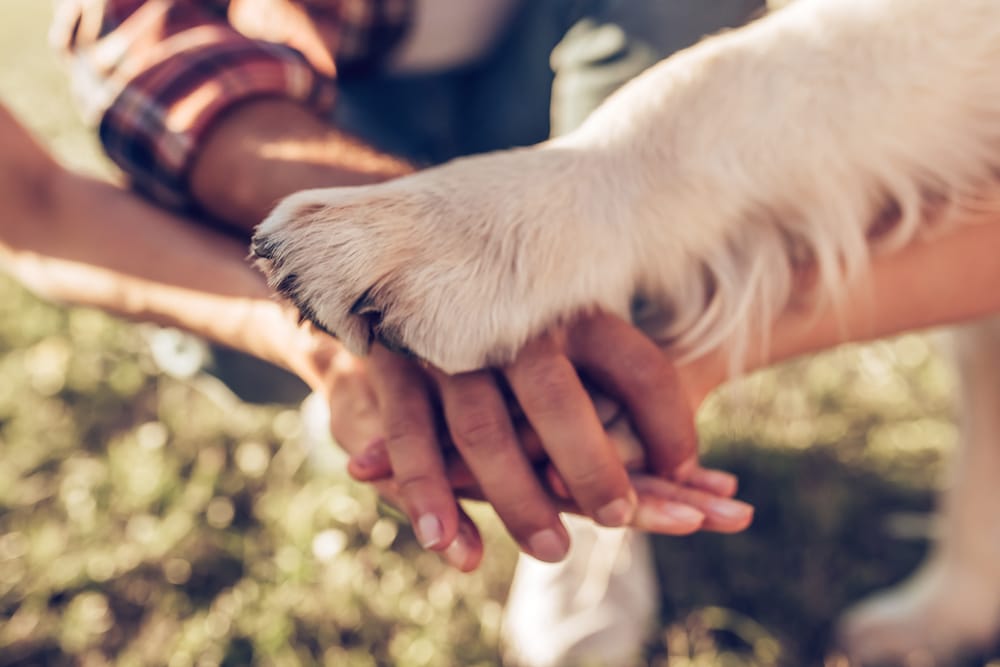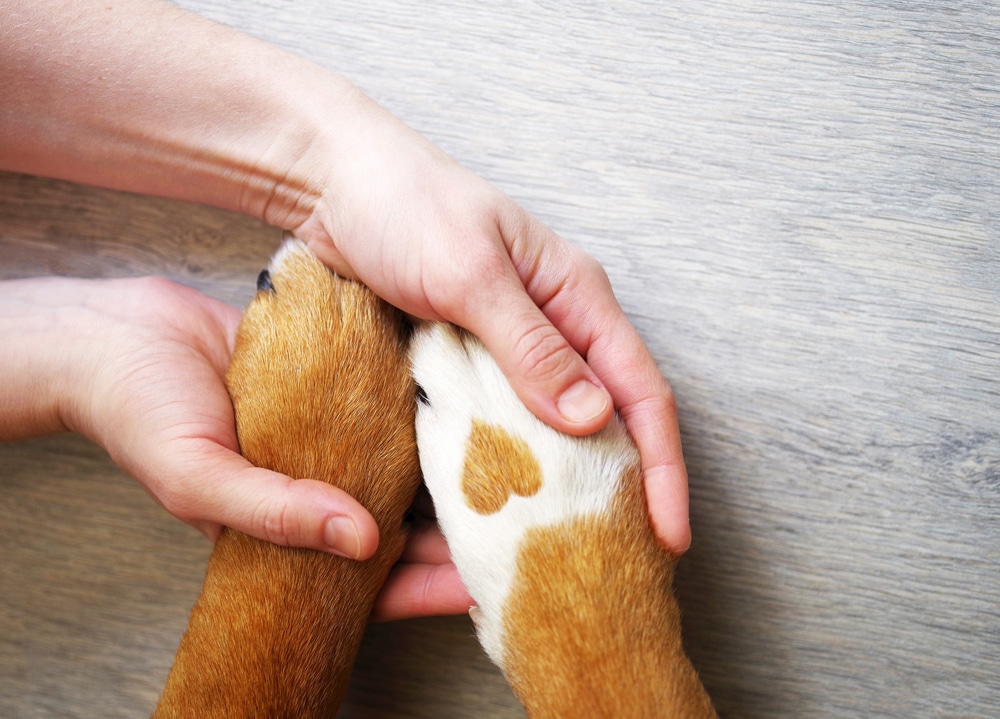Have you ever been sitting down and noticed your dog walk up to you, place its paw on your arm or leg, and give you a loving stare? Dogs have a natural instinct to touch things with their paws, just as we do with our hands. This behavior, known as “pawing,” can have a variety of meanings. But why do they do it? Is there a specific reason your dog puts his paw on you?
Dogs typically paw at you for a variety of reasons. It could be a sign of affection and excitement, to demand something, to show discomfort or pain, or as a puppy, to try and nurse. Other reasons include going for a potty break, showing submission or asking for forgiveness, getting your attention, or doing so in response to feeling threatened or scared.
Table of Contents
- 10 Reasons Why Your Dog Put Its Paws On You
- 1. As A Sign Of Playfulness Or Excitement
- 2. To Demand Something, Such As Food
- 3. To Go For A Potty Break
- 4. To Show Affection Or Give You “Hugs”
- 5. In Response To Feeling Threatened Or Scared
- 6. To Get Your Attention
- 7. They Want To Go Outside For A Walk
- 8. As A Sign Of Discomfort Or Pain
- 9. To Show Submission Or Ask For Forgiveness
- 10. As A Puppy, They May Try To Nurse On You
- Is It Okay For A Dog To Put Its Paws On You?
- In Conclusion: Why Does My Dog Put Its Paws On Me?
10 Reasons Why Your Dog Put Its Paws On You

Here are 10 potential explanations for why your furry friend might be pawing at you.
1. As A Sign Of Playfulness Or Excitement
When I see my dog walk up to me with its tail wagging and paws outstretched, I know that it’s just begging for a good game of fetch or tug-of-war. My pup is always excited to see me, and one of the ways it shows me its love is by pawing at me. It’s almost as if my dog is saying, “Please can we play? I’m so excited!” And I can never resist those big puppy eyes.
2. To Demand Something, Such As Food
Dogs are known for being demanding, especially when it comes to treats and affection. If your pooch is constantly pawing at you while you eat or while you’re on the phone, it’s likely because they want something from you. It could be attention, a treat, or even just to have their water bowl filled up.
3. To Go For A Potty Break
A lot of dog owners might be familiar with the pawing and circling behavior that happens when it’s time for their furry friend to go outside for a bathroom break.
This is your dog’s way of communicating its need to relieve itself, and it should not be ignored as it could lead to accidents in the house.
4. To Show Affection Or Give You “Hugs”
Dogs can be very affectionate animals, and it’s not uncommon for them to show their love through physical touch.
If your dog gently places its paw on you while giving you adoring glances, it could be a sign of affection and a way for them to physically connect with you. They may also wrap their paws around your arm or neck in what can be described as a “hug.”
5. In Response To Feeling Threatened Or Scared
Animals do not possess the ability to talk to express their feelings. They must use their body language or specific gestures instead. So, when your dog feels threatened or feels something unusual is going on, it’ll use any way of communication to inform you about what happens. Pawing at you may be one of that ways.
This is most likely to happen if there is something frightening your dogs, such as a loud noise outside or another animal in the room. In that situation, try to calm it down and make it feel more secure. You may need to remove whatever is causing the fear or threat.
6. To Get Your Attention
Do you know dogs are close to its owner just like family members? Being so close to you means they wish to spend a lot of time with you. To get your attention, they’ll try to connect with you, and perhaps they’ll start pawing too.
This may be because they want you to pet them, play with them, or just give them some general attention. If you think this is the reason your dog is pawing at you, try giving it the attention it wants. This may mean:
- Petting him
- Playing with him
- Just talking to him
If the pawing stops, then you have likely correctly identified the reason. Still, it would be worth experimenting with in the future, and you’ll want to be careful because doing this too much will communicate to your dog they’ll always be able to get your attention in this way, meaning they’ll keep doing it.
7. They Want To Go Outside For A Walk
Walking is one of the best things you can do for your dog. It provides them with much-needed exercise, fresh air, and stimulates their mind. When the weather is good, all you may want to do is spend some time outdoors. The same goes for your furry friend too.
When it’s a sunny day and they want to go out for a walk or just to run around in the yard, they may paw at you as a way of telling you this. If this is the case, get your leash and take them for a walk!
8. As A Sign Of Discomfort Or Pain
When a dog paws at its owner it could be restless and uncomfortable with its surroundings. If your dog is pawing at you, and seems to be doing it in a way that is almost digging into you, it may be trying to tell you something hurts.
This is most likely to happen if your dog has an injury or is ill. If you think this is the reason your dog is pawing at you, take it to the vet as soon as possible.
9. To Show Submission Or Ask For Forgiveness
Did you know dogs are famous for how well they learn?
A trained dog can differentiate between good and bad acts. So when your dog does something wrong and knows you will not be happy, they can surprisingly show submission or ask for forgiveness.
Pawing is the most instant action for that purpose. This is most likely to happen if your dog has done something wrong and knows it. For example, a dog may paw at you after it has chewed up your shoes or gotten into the trash.
If you think this is the reason your dog is pawing at you, try to forgive it, and move on. The best way to show your forgiveness towards your puppy is to show it some love.
10. As A Puppy, They May Try To Nurse On You
Puppies that have just been separated from their mother may try to nurse things as a way of finding comfort. This may include pawing at you or trying to suckle on your clothing or skin.
If this is the case, try offering your puppy a stuffed toy or blanket they can use as a substitute for nursing. It is important to redirect this behavior so the puppy does not continue to try and nurse on you or others as it gets older.
Is It Okay For A Dog To Put Its Paws On You?
Some dog owners may not mind their dog putting their paws on them, but it is important to teach your dog appropriate boundaries and not allow them to do this. In some situations, such as if a dog puts their paw on someone who is scared of dogs or does it too forcefully, it can be seen as aggressive behavior and may cause discomfort or fear in the person being pawed at.
It is best to redirect your dog’s pawing behavior and teach them more appropriate ways of asking for attention or affection, such as sitting politely or giving a gentle paw tap.
Additionally, consistently reinforcing good behavior will help your dog understand what is and is not acceptable.
In Conclusion: Why Does My Dog Put Its Paws On Me?
So, dogs are intelligent creatures that can learn a lot of things. And one of the smartest things they learn to do is communicate with us through body language and actions. So, when your dog puts its paws on you, it’s important to try and understand why it’s doing so.
In most cases, there is a specific reason for this behavior, and once you identify it, you can take appropriate action. If you’re still unsure about what your dog is trying to tell you or need help correcting this behavior, consult with a professional trainer or behaviorist.
So what are your thoughts on this topic? Do you have any stories or experiences to share about your own dog putting their paws on you? Let us know in the comments below!
